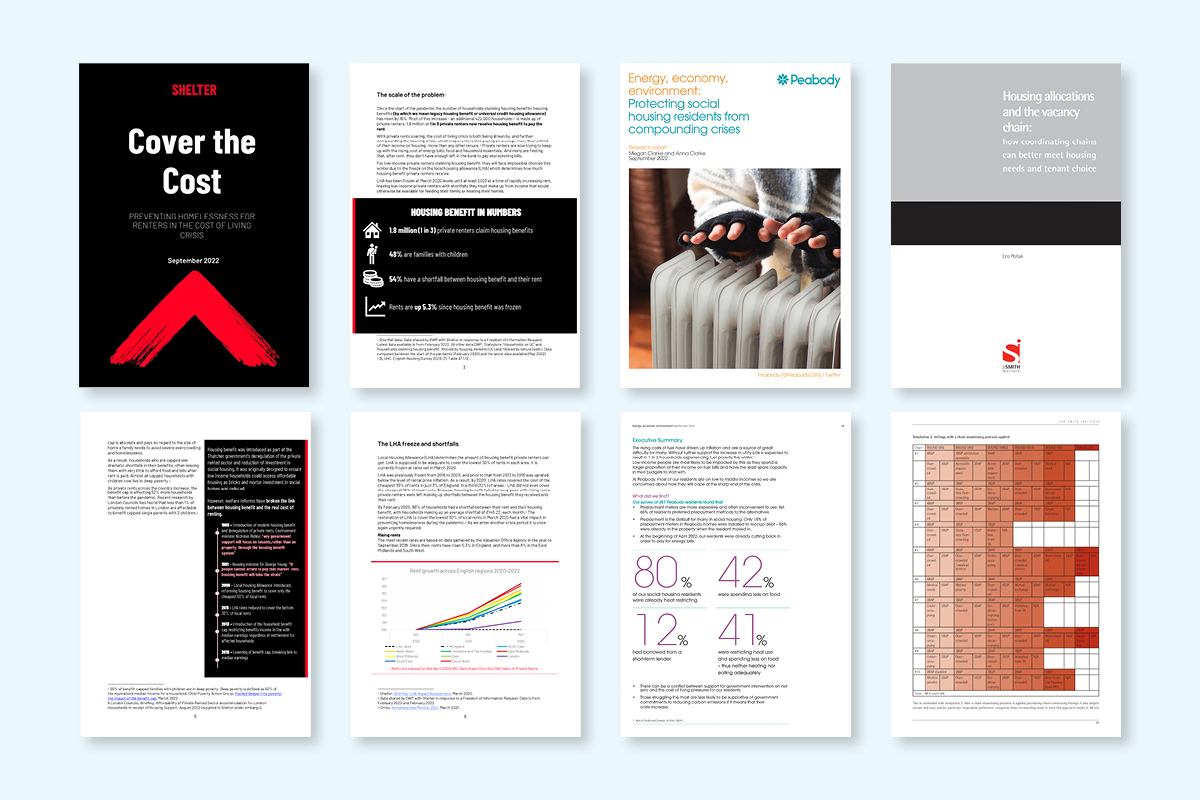The Thinkhouse Review: a perfect storm of spiralling rents and out-of-control bills
Steve Moseley says the current political and economic environment provides an interesting backdrop to the latest group of reports that feature in this month’s Thinkhouse Review of the latest and most thought-provoking housing research
With an intensifying energy crisis, a fiscal event that will linger long in the memory for many reasons and a patchy economic outlook, the eight reports published in September focus on some familiar current themes, with the cost of living crisis in particular featuring heavily.
However, despite the common areas of focus, the range of reports produced in September manage to look at these issues from a variety of different perspectives and policy lenses, contributing hugely to the overall quality of debate – exactly as good research should do.
The standout report for me is Shelter’s Cover the cost: preventing homelessness for renters in the cost-of-living crisis.
I love reading Shelter’s reports because they are always brilliantly written and researched, backed by great insight and analysis but presented in a format that is accessible and easy to read and sets out some clear policy recommendations.
This report looks at the significant impact the cost of living crisis is having on households living in private rented homes who, in the words of Shelter, “face a perfect storm of spiralling rents and out of control bills which threatens to push many towards the brink of homelessness”.
The statistics that back up this analysis are stark: a third of private renters are spending half or more of their monthly income on rent and over half are in receipt of housing benefit but still left with an average shortfall of £151 per month.
In addition to the economic backdrop, Shelter highlights the freeze on Local Housing Allowance (LHA) levels until at least March 2023 as a major contributory cause to this situation, meaning it now covers the cheapest third of rents in just 3% of England. This is compounded by the benefit cap, which now impacts 120,000 households.
So, what is to be done? Well, Shelter sets out five clear recommendations, including restoring LHA rates to the 30th percentile, abolishing the household benefit cap, and reiterating a long-standing Shelter ask for investment in a new generation of social housing.
Adopting a similar theme, but approaching it from a different perspective is my second highlighted report: Energy, Economy, Environment: protecting social housing residents from compounding crises published by Peabody.
This in-house research was undertaken in April 2022 and consisted of a roundtable and survey of residents. While the sample survey isn’t large, it provides some well-presented data on the impact on residents from energy prices and the cost-of-living crisis.
The headline figures bluntly summarise the critical nature of the issue: over 80% of residents surveyed have already restricted their use of heating, 42% are spending less on food and 41% have had to restrict expenditure on both, thus they neither have heating and are not eating adequately.
The report sets out some practical recommendations which also link to the need to address the environmental sustainability of social homes, with the significant challenges attached to achieving net zero only exacerbating the fuel poverty of residents. These include the implementation of a social tariff to equalise costs between prepayment and direct debit customers, uprating of benefits in line with inflation and greater support for the decarbonisation of social housing homes.
The final report which caught my eye is the Smith Institute’s Housing allocations and the vacancy chain: how coordinating chains can better meet housing needs and tenant choice. While this might seem a fairly dry subject among the more headline-grabbing research reports, it tackles a really important topic that is impacting the lives of residents both already in social housing and those on long waiting lists.
Focused on London, the report explores approaches and methods which could support a more strategic approach to lettings and answer the problem statement of how each available home can be used to alleviate as much housing need as possible. The context for this is a 70% fall in ‘churn’ among social homes since 2007, which by 2019-20 resulted in a situation where only 3% of London’s total available social homes churn on an annual basis.
In terms of solutions, the report focuses on creating more vacancy chains where each home let is used to initiate moves in a chain of other properties, ensuring more residents are helped into homes suitable for their needs.
The report is split into five sections and includes a literature review, analysis of statistical datasets, interviews and workshops with those involved in lettings, and features a number of helpful case studies. It outlines a number of practical ways in which vacancy chains could be improved.
With the supply of genuinely affordable housing continuing to track so far below current needs, it feels like an important contribution to the debate of how we maximise a scarce resource while – linking back to where we started and the final ask of Shelter’s report – highlighting the importance of investing in a new generation of social housing.
Steve Moseley, group director of governance, strategy and communications, L&Q
Sign up to our Best of In-Depth newsletter
We have recently relaunched our weekly Long Read newsletter as Best of In-Depth. The idea is to bring you a shorter selection of the very best analysis and comment we are publishing each week.
Already have an account? Click here to manage your newsletters.













